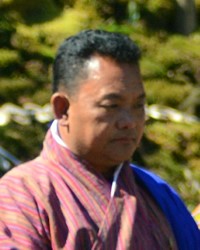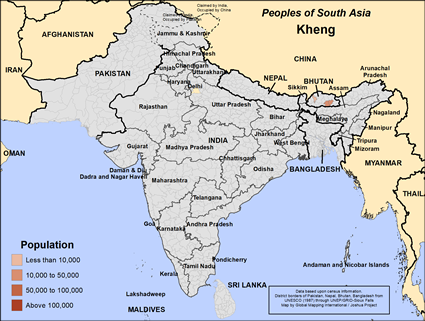Kheng people live in southcentral Bhutan. It is the most widely spoken of the Eastern Tibetan languages in Bhutan. The Kheng inhabit a widespread area in the southcentral part of the kingdom, concentrated in Zhamgang District and western Mongar District. Zhamgang was once a collection of tiny principalities that were absorbed into Bhutan in the 17th century. One source gives specific details regarding the distribution of the Kheng: 'Near Zhamgang, the northernmost Kheng speaking village is Wangdugang on the Mangdechu [River]. Around Zhamgang the Mangdechu forms the boundary between the Kheng and Nyenkha speaking areas. South of the village of Takma, however, Kheng is spoken on both sides of the Mangdechu. In the east, the Kurichu River forms the boundary between the Kheng and Tsangla speaking areas. As one crosses the high mountain ridge traveling south from Zhamgang on the main road, one enters Nepali speaking territory. '
The Kheng language is part of the Eastern Tibetan branch of Tibeto-Burman. It is closely related to, yet distinct from, Bumthang and Kurtop. Kheng reportedly has 92 per cent lexical similarity with Bumthang, and just 47 per cent with Dzongkha (the national language of Bhutan). George van Driem says, 'Although it could be argued that the two languages Kheng and Kurtop are dialects of Bumthang on grounds of mutual intelligibility, there are essential differences between the phonologies of Kheng and Kurtop on one hand and that of Bumthang on the other. Moreover, the speakers of these three languages identify strongly with their respective homelands in Bumthang, Kurto and Kheng.... The district capital of Kheng is Zhamgang proper. It has three dialects, all of which have significant differences. Within the vast Kheng area there is considerable dialect diversity, both lexically and in the way certain tenses are formed. Bhutan is having trouble finding teachers to teach in this language.
Like most peoples in Bhutan, the Kheng are farmers, who grow what they can, and they raise livestock. Their main crop is corn. Commonly, the younger generation is leaving the villages to get better jobs in Thimpu, the capital city of Bhutan.
Tibetan Buddhism is the professed religion of the Kheng, although the pre-Buddhist shamanistic Bon religion also yields great influence. 'The Bon religion is widespread throughout Kheng, where it is practiced in syncretic coexistence with Buddhism. One expert on Tibetan Buddhism noted, that when ‘tantric Buddhism entered Tibet... it began a centuries-long battle with Tibet's native shamanism. In the end, tantric Buddhism prevailed only by absorbing much shamanist practice, and the shamanists survived by adopting a thin veneer of Buddhism. '
In the early 1990s, the first Kheng people believed in Christ. Today there is a small group of believers, struggling to establish the Christian faith among this unreached people group.
The Kheng people need a gospel witness, no matter where they live.
Pray for loving workers to go to the Kheng people in Bhutan.
Pray for Kheng disciples to make more disciples.
Pray for a movement to Christ among the Kheng people throughout the Himalayan region.
Scripture Prayers for the Kheng in Bhutan.
Peoples of the Buddhist World, Asia Harvest, Copyrighted © Used with permission
https://en.wikipedia.org/wiki/Kheng_people
https://factsanddetails.com/south-asia/Bhutan/People_Bhutan/entry-7905.html
https://web.archive.org/web/2012021214544
| Profile Source: Joshua Project |











